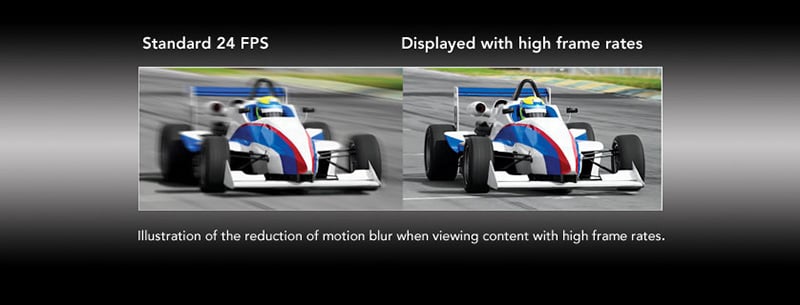High frame rates
The future of cinema is sharp and smooth.
High Frame Rate (HFR) movies play visuals at higher speeds so viewers see fewer motion artifacts, as well as less motion blur and stuttered movement on-screen. For 3D movies in particular, the results are dramatic and ultra-realistic.
HFR explained

24 frames per second
Films shot and delivered at 24 fps have persistent problems with flickering and stuttering due to too few frames for fast moving objects to smoothly transition across a large screen. Additionally, each frame is suspended for a longer duration, adding to the overall stuttering effect.
|
60 frames per second
Increasing the frame rate not only provides more frames to better represent fast moving objects, it also provides increased image detail as the camera shutter is open for 2.5x less time per frame.
|
What you get with Christie® HFR digital cinema projection
- Completely immersive 3D - entice moviegoers with high-value, immersive cinema experiences that they can’t get at home
- Picture-perfect images - With no flicker, motion blur and stuttering, your audiences will notice the crisp and life-like realism of HFR cinema
- More alternative content - HFR-upgraded cinema projection enables you to show premium sporting events, live events and dance
For the cinema business, adopting HFR projection means increased audience satisfaction, more repeat patrons and a growing bottom line.
For directors and cinematographers, HFR technology offers a new medium for storytelling. The wider range of camera moves that HFR supports give filmmakers enhanced creative freedom.
Christie’s HFR digital cinema solutions
Christie Solaria™ Series digital cinema projectors, with laser and Xenon-based illumination, can be upgraded to show feature film and alternative content released at 48 or 60 frames per second (i.e. a high frame rate), by adding Christie’s integrated media block. Christie IMB, when added to Christie Solaria Series projectors, provides full 2K HFR 2D and 3D support for feature film content.
Frequently asked questions
How do high frame rates affect the visual quality of videos and movies?
Higher frame rates improve the visual quality of videos and movies as they generate crisper, more realistic images with less motion blur because more frames are visible per second. High motion video and video games see a significant benefit from high frame rate projection and displays.
What is the ideal frame rate for a projector?
The ideal frame rate for a projector depends on the application. Most projection content is available in 30-60fps, making 60fps an ideal frame rate for most projection applications, but 3D and VR simulations could benefit from higher frame rates.
Having a frame rate of 60fps and above generates a higher quality image with less motion blur because more frames are visible per second.
Are high frame rates necessary for virtual reality (VR) applications?
High frame rates improve virtual reality (VR) applications because they provide crisper, more realistic visuals, lessen motion sickness and disorientation, improve hand-eye coordination, and enhance immersion.
Is there a difference between frame rate (fps) and Hertz (Hz)?
Hertz (Hz) measures how many times the entire screen is updated per second, while frame rate (fps) indicates how many individual frames are shown per second. Both contribute to the quality of visual experiences, especially in dynamic and fast-moving content.
